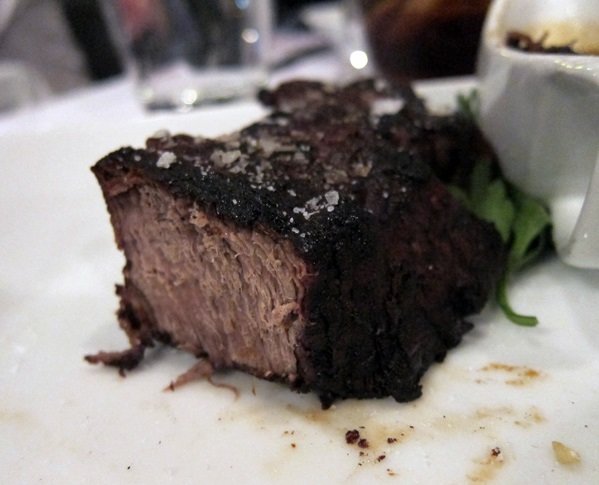On an otherwise smooth night, a guest summoned me to his table in a panic because he was disappointed with the Filet Mignon he had ordered well done. His complaint, predictably, was that the steak was dry. Everyone—except this guy, apparently—knows that Filet Mignon has very little fat and should not be served past medium rare. But before I could even respond, he launches into a five-minute diatribe about how a properly cooked well done steak should still be juicy. He pointed to the dark crust on the outside that was studded aggressively with black pepper and explained that it also shouldn’t be burnt (it wasn’t). To prove that it was dry, he offered me a taste of his steak—one of my pet peeves because I find it insulting to be offered someone’s half-eaten food. Only a person who doesn’t see you as an equal would offer you his leftovers.
I brought the dish back to the kitchen bracing for the inescapable moment where the chef needs an explanation for the inexplicable. I told the chef that the guest wanted the steak remade, juicier this time. The silence in the kitchen was deafening. You could hear the chef’s blood pressure rising as he stared blankly at the dehydrated Filet. He explained the obvious that re-firing the steak would yield exactly the same result. It would also take an extra twenty-five minutes to cook.
So, I returned to the table and, on the chef’s behalf, suggested we prepare the steak medium well instead. The guest agreed and, of course, was annoyed by the wait and underwhelmed by the second iteration. The whole ordeal was a reminder of how often in hospitality we’re expected to show deference to ignorant people.

When a guest doesn’t like the way a dish tastes, it’s easy. You take the dish away and replace it with a refurbished one or you offer alternatives. When a guest doesn’t like something because he thinks the dish is improperly cooked, it’s more complicated. “My pasta is undercooked” (no… actually it’s perfectly al dente). “These clams are too salty” (no… they have natural salinity). “My cappuccino isn’t hot enough” (no… a properly made cappuccino isn’t supposed to be scalding).
The customer is not always right and, when these things happen, the staff is faced with the inevitable dead end of having to confront someone’s meritless complaints. We usually choose the path of least resistance, but taking the high road requires us to prostrate ourselves before untoward guests.
Some diners describe the way they like their meat cooked in abstract terms. “I like mine pink but not bloody, just a touch more to the rare side of medium.” Sadly for them, a line cook with twenty steaks on the grill doesn’t have time for an existential conversation about how each individual steak is cooked. The mnemonic scale of doneness (R-MR-M-MW-W) exists for a reason. If we don’t standardize a language for cooking meat, then we will spend the entire night recooking steaks.
Incorrect meat temperatures are the most common instances where food is sent back in restaurants, and so often the guest’s judgement is wrong. Chefs will rarely stand their ground and refuse to make the dish again when it was cooked properly the first time. In the hospitality game, we’re trained to give people what they want and sometimes that means putting our pride aside and doing it over again even when we know it was right the first time.


A well done steak doesn’t need to be dry or tough as leather. A well done steak, in fact, can be just as juicy and flavorful as a medium rare or rare, but without the flavor of the raw protein that comes from the “blood” which many people like myself find disgusting. I’ve had many opportunities to eat well done steaks that were delicious, and many many more opportunities to eat disgusting and dry well done steaks. You know what the difference was? The former actually treated me with dignity and respected how I wanted to eat my food, and… Read more »